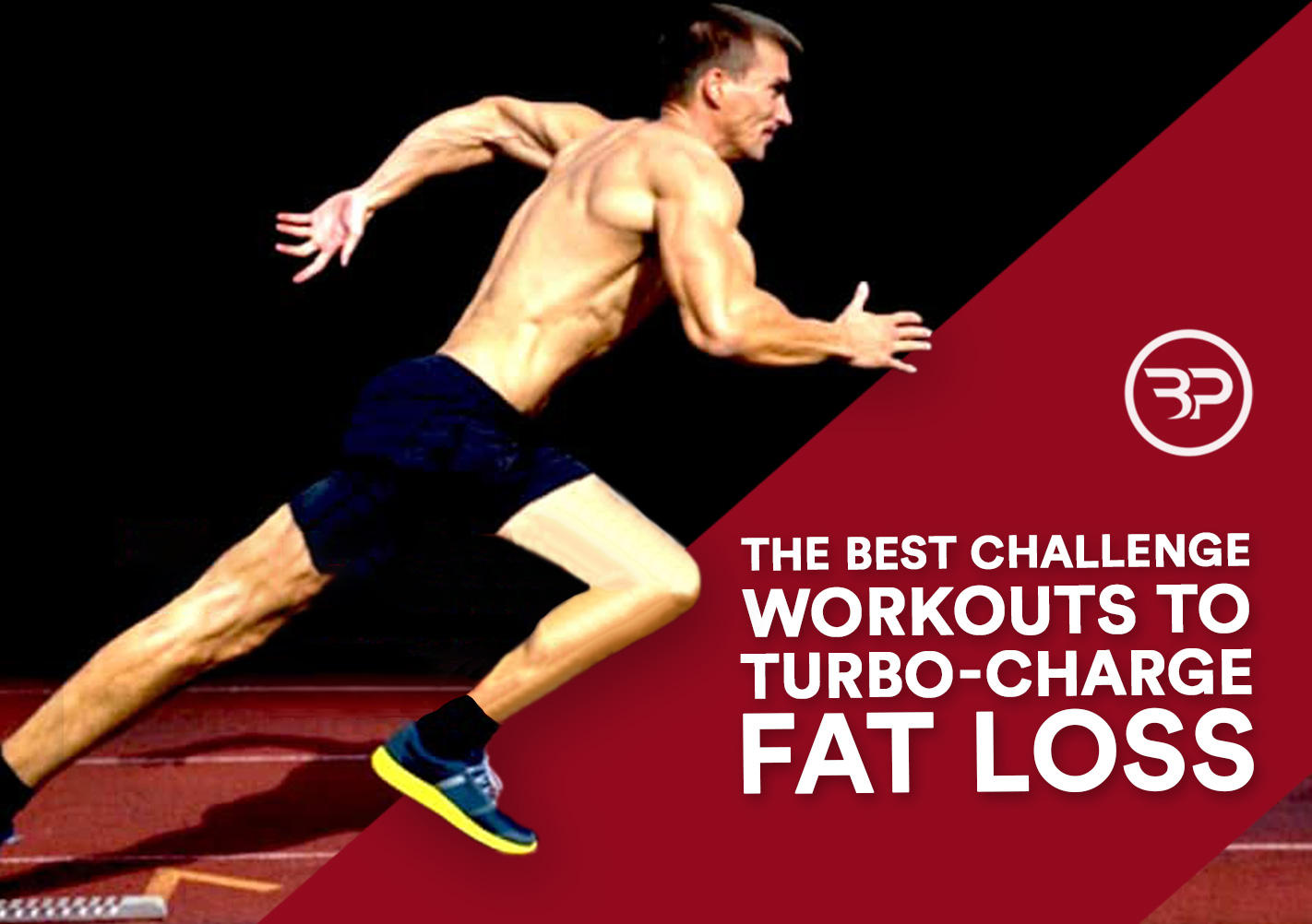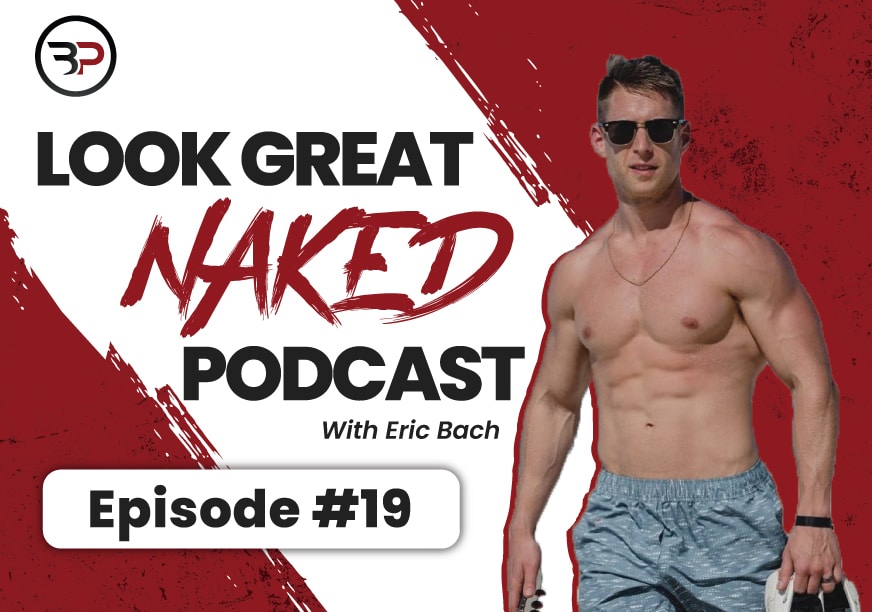The Best Challenge Workouts to Turbo-Charge Fat Loss
September 7, 2016
Torching fat and preserving your hard earned muscle requires you to train like a strong, disciplined, badass.
That means any old routine won’t cut it if you want to be jacked, strong, and athletic.
That requires something extra; a more sinister approach. And your lifting isn’t the problem. You dig the weights. They get you bigger and stronger. And make you feel like Hercules.
But cardio?
Not exactly the first thing that springs to mind when you think of building a lean and athletic body. Many lifters are consumed by an irrational fear: turning into emaciated ultra-marathoning weaklings as muscles waste away.
But it just ain’t so.
I say again: conditioning like a high-performance athlete gets you shredded. And it improves your speed, power, and overall training.
To maximize fat loss and reveal your ultimate high- performance body, remember one key principle. Adaptation is the enemy.
You don’t want your body to adapt and improve at a particular skill. The easier your conditioning, the less effective it becomes for fat loss. So you need to embrace the suck, bro.
Some brutal conditioning tests follow. But first: why you need to more of the stuff you hate.
Adaptation is the Enemy for Fat Loss
Conditioning for sport and conditioning for body composition are different animals.
Conditioning for a sport requires you train the skills needed to improve your game while fatigued. Your goal is to become more skilled by testing yourself in ways that carry over to a sport and the fatigue of competing.
Drills great for sport-specific conditioning include:
- Shooting free-throws between suicides on the basketball court
- Performing six seconds of all out sled pushes for football to match the duration and intensity of a play.
- 300 meter sprints at 85% of max speed for 200-meter sprints
Conditioning for performance improves specific skills and drives athletic performance.
And while repeating sport-specific “cardio” or conditioning drills improve performance, they become increasingly less effective for fat loss.
Let’s use running as an example. Sedentary people who start pounding the pavement often have great initial fat loss results. But after losing the first few pounds, they continue to get faster and better at running. But fat loss stagnates.
The problem?
We’re no longer meeting Davis’s Law: the Minimal Essential Strain (MES) needed for tissues to adapt. Since your body acclimates to the chosen conditioning, the tissues generating force are no longer challenged to adapt and change. They get more efficient. And efficiency is the bane of fat loss training.
The more challenging and new a conditioning model is, the harder the body works to get efficient. During the process, you’ll burn a boatload of calories as your body figures out the new stressor required to adapt, survive, and thrive. Keep hammering the basics while lifting, but get creative with your conditioning to shred body fat.
Energy Systems Basics and Fat Loss
Your energy systems are broken into three parts: The ATP-PCR, Glycolytic, and oxidative systems. At any moment, all three systems are at work, but the intensity of work depends on the intensity and duration of exercise.
ATP-PCR System
Like a NOS boost in Fast and Furious, the ATP-PCR system brings the power, baby. Power is the rate of work in an exercise. Thus, your ATP-PCR system is firing most prominently during explosive, all-out exercise. Oxygen isn’t used, so energy is all-out, then gone after eight to twelve seconds, kind of like your first time in the sack. The ATP-PCR system gives you the ability to generate insane power, speed, and strength, but fatigues quickly.
Think of ATP-PCR for 100-meter sprints, a set of power cleans, or a set of broad jumps. Once time expires, you need to recover to produce the same intensity, or your technique and performance declines.
Glycolytic System
After you blow through your ATP-PCR system, the glycolytic system kicks into gear. The glycolytic system breaks down glucose or stored glycogen to create energy after about twelve seconds when ATP-PCR fizzles out.
Think of the glycolytic system in two ways:
Fast Glycolytic system: Up to 30 seconds of high-powered activity, like a 200-meter sprint.
Slow Glycolytic System: 30-90 seconds or so of moderate-high powered activity, like a 400-meter sprint or long timed set of squats.
Since your body is working harder to burn fuel and support activity, that eye-splitting build-up of metabolites that make your legs feel like jello kicks in. Fatigue diminishes power performance.
Even with more fatigue, both energy systems generate high levels of force to sustain power and strength. But unless you train with high intensity for 15-90 second bouts, your power and energy will wane as your body fills with metabolites from all-out muscular contractions.
The Oxidative System
This is the classic cardio model, like hitting the trails for a run. This provides slower, but a lot more energy via both fatty acids and stored glucose in your body.
Unfortunately, many people still think it’s cool to bash oxidative, or aerobic work. Most of this betrays faulty logic. It’s a cop-out for lazy people content in an everlasting bulking phase.
The truth?
Adding cardio and using the oxidative system provides a tremendous potential for energy production, but less explosive power.
The problem? Less explosive power and fears of a building a cortisol ridden, muscle wasting body scare off most lifters.
But it shouldn’t. Think of improving your aerobic, or oxidative system, like building a foundation of max strength.
Without a base of max strength, your muscle and power building training blow donkey nuts.
Similarly, without a base of aerobic conditioning, your body will generate explosive force once or twice but then gets so riddled with fatigue that you’re worthless after one or two sets.
When you’re conditioning with high-intensity exercises like sprints, having a strong aerobic system helps clear out the metabolites that cause your lungs to scream and legs feel like jello. This improves your ability to recover and hit another set, thereby improving your work capacity to train longer and harder.
Seems more important now, right?
A strong aerobic capacity builds your capacity to maintain high-intensity efforts, longer.
Use longer duration exercises over 90 seconds, like biking, hiking, moderate intensity strength circuits (and yes, running) to improve your oxidative system.
All Energy Systems Are Important
All energy systems are always in play. But the amount of work each does is dependent on the intensity of the exercise. A power clean might be 90% ATP-PCR, 7% Glycolytic, and 3% oxidative.
So why does his matter?
All energy systems burn different fuels. ATP-PCR might be sexy and high-powered, but your ability to burn calories is limited. Since you’re crushing explosive and heavy lifting strength training, you’re likely hitting this energy system sufficiently. Since ATP-PCR is generated via creatine phosphate, creatine supplementation is important for performance.
The glycolytic system is the sweet spot. The high intensity produces anabolic changes in your body while staying short enough in duration to keep you sane. The glycolytic system name says it all, as it burns through muscle glycogen and blood glucose. So, carbs.
Further, working for longer durations in the glycolytic system has been shown to increase levels of growth hormone, further stimulating fat loss. (1)
This is where the majority of your conditioning work needs to be:
30-90 second high-intensity bursts.|
A strong oxidative system builds the foundation to improve high-intensity exercise performance. Your body will get more efficient at breaking down carbs and fat for energy.
And while spending all your time in the oxidative system isn’t ideal for body composition or power performance, it still has its place.
Spend more time walking, less time sitting, and pick up the tempo in your auxiliary work. Minimize rest between your isolation supersets at the end of training. Enough science. Let’s give you actionable steps and wicked conditioning drills to take your body to the next level.
The Conditioning Tests for Fat Loss
These conditioning tests only scratch the surface of the variety available for conditioning.
These tests combine running, rowing, biking, bodyweight training, and weight training circuits. Keep it simple, keep it brutal, and watch the fat fall off.
100 Yard Sprints: 16-20 seconds
A classic football drill. All you do is Sprint from end zone to end zone on a field. Yea, it’s a little farther than 100 yards, but you get the idea, bruh. Rest 45 seconds and repeat.
Elite Level: Ten sprints between 16-20 seconds while adhering to the rest interval.
Bike Intervals
Perform 20 second all-out sprints, followed by 40 seconds of rest for twelve sets.
Start with a two-minute warm-up and end with a two to five-minute cool down.
Elite Level: Perform the sprints on the highest resistance possible without tossing your cookies on the guy in front of you.
Stairs: 15 Minutes of Misery
Run up, walk down, and increase the number. Keep it simple and push the pace.
Elite Level: 20 trips within a 15-minute time limit. This depends on the size of your stairs, but the ones I use has three flights.
500 Meter Row Challenge
Primary Emphasis: Oxidative/glycolytic system
This is the great equalizer. A lot of people use bikes, sprints, and sleds for conditioning. Rowers? Few beyond the CrossFit community.
Hop on a rower, set the difficulty to ten, and row 100 meters to warm-up. Reset the rower and row 500 meters as fast as possible. Take a 3-5 minute protocol or you’ll toss your cookies on the floor, trust me.
Elite Level: 1:30 seconds for 500 meters.
Strength Circuits
Pick major movement patterns that incorporate a ton of muscle mass. Think hinge, squat, press, pull, and carry movements. Plan 3-4 movements together and get after it.
Kettlebell swing x30 seconds
Single arm kettlebell walk x30 seconds/arm
Push Up x 30 seconds
Rest 0-60 seconds
Elite Level: Complete eight straight sets without breaking form.
Bodyweight Conditioning
Pick major movement patterns that can be done without much equipment. Think push-up variations, pull-ups, squats/single leg squats, and jumps. Then, add the finishing touches with a finisher movement like burpees, mountain climbers, or jumping jacks.
Chin-Up (or inverted Row) x5
Squat Jump x10
Push-Up x15
Mountain Climber x20
Set a timer for 15 minutes and get to work.
Elite Level: Ten total sets in 15 minutes
300 Meter Shuttle
This was (and still is) the bane of my existence from the old pigskin days. It’s a hell of a challenge and highly effective for forging an iron body and mind.
Set markers 50 meters apart. Sprint down and back three times, rest 3 minutes between them. Perform two or three sets, then go home.
Elite Level: Reduce rest period from three minutes to two Perform each of the three runs in under 50 seconds.
The Takeaway
I prefer to rotate through conditioning exercises on a bi-weekly basis. This gives you familiarity with a skill like sprinting to improve performance while providing variation to keep exercises challenging and forcing fat loss. Remember, for maximum fat loss adapting to the exercise is best avoided.
Week One:
Monday: Lift Heavy upper. Bodyweight Conditioning.
Tuesday: Off
Wednesday: A.M.: Heavy Lower body lift.
(Glycolytic focus) P.M. 2-3 x 300-meter shuttle.
Thursday: Low intensity (Oxidative) CV, 20-30 minutes of steady state cardio.
Friday: Volume Upper Body
Saturday: Off
Sunday: (glycolytic and aerobic focus) Stairs: 15 Minutes of Misery
Week Two:
Monday: Lift Heavy upper. Strength Circuit (ATP-PcR, glycolytic)
Tuesday: Off
Wednesday: A.M.: ATP-PCR Focus ( 5×100 meter sprint. Rest 120 seconds).
P.M. Heavy Lower body Lift.
Thursday: Low intensity (Oxidative) CV, 20-30 minutes of steady state cardio.
Friday: Volume Upper Body (Glycolytic): 500 meter Row Challenge.
Saturday: Off
Sunday: (glycolytic and aerobic focus) Stairs: 15 Minutes of Misery
How to Look like an Athlete and Lose Fat like a Pro
Condition two or three times per week. Scared about losing muscle? Eat more. You still have no reason to be an out of shape, pudgy pie.
Condition either as a separate workout 4-6 hours+ away from lifting, or right after hitting the weights.
If you’re going to sprint, keep it in at least once per week. It’s a skill that needs practice, and at least once per week will help reduce the incidence of injury.
Choose a conditioning exercise that lasts anywhere from 10 seconds to two minutes.
Work hard. You don’t need to be hyper-specific. If you can’t hold down a conversation without gasping for air, you’re working hard.
Throw on some jams and get to work. Keep it fun. It’s time to conditioning like an athlete and shed fat like a pro. Are you ready?
If so, I’d be happy to help with a custom program, hand-crafted just for you. Just shoot me your name, email, and why you’re ready to look better naked and crush your training in the form below.
[sc name=”Online Coaching”]
Reference
Vanhelder, W.P., Goode, R.C. & Radomski, M.W. Europ. J. Appl. Physiol. (1984) 52: 255. doi:10.1007/BF01015205








